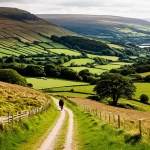Uncovering Lesser-Known Historic Towns and Villages
Discovering hidden UK towns offers a unique way to experience authentic British culture without the crowds. These secret British villages hold rich heritage and stories rarely found in mainstream travel guides. For cultural travel, UK explorers value places where history whispers through quiet streets and traditional architecture remains untouched.
Take, for example, the village of Lavenham in Suffolk. Known for its striking medieval timber-framed buildings, it stands as a testament to England’s prosperous wool trade era. Unlike busier historic towns, Lavenham’s charm lies in its serene ambiance and friendly local shops. Reaching such towns often involves scenic drives or short train rides to rural stops, letting travelers absorb the countryside on the way.
Additional reading : How Can Travelers Make the Most of UK Tourism Hotspots?
Another gem is Clovelly in Devon—a steep, pedestrian-only village clinging to cliffs above the Bristol Channel. Its cobbled lanes and no-car policy create an immersive experience, perfect for cultural travel fans seeking the essence of traditional British village life.
Insider tips for visiting include arriving early to avoid occasional tourist bursts and engaging with locals at village pubs or markets to unearth stories and customs, enriching your understanding of Britain’s diverse historical fabric.
Also read : What Are the Unexpected Delights of Exploring Unpopular UK Destinations?
Unique Independent Museums and Galleries
Step off the beaten path to explore some of Britain’s most obscure UK museums and undiscovered art galleries. These venues showcase alternative culture Britain in its rawest and most innovative forms. Unlike mainstream institutions, these hidden gems often house rare collections, experimental art, or local histories that mainstream museums overlook.
For instance, small independent museums might feature artifacts from niche subcultures or pioneering contemporary artists rarely seen elsewhere. Their exhibitions frequently challenge traditional narratives, inviting visitors to engage with cultural expressions that are fresh and thought-provoking.
When planning a visit, note that operating hours and ticketing can be irregular, so checking ahead is crucial. Many offer affordable or pay-what-you-wish entry, enhancing accessibility. The visitor experience at these spaces tends to be intimate and interactive, often guided by passionate staff or even the artists themselves.
By seeking out these distinctive museums and galleries, you not only support local creative communities but also gain insight into Britain’s vibrant alternative cultural landscape that remains largely undiscovered by mass tourism.
Immersive Local Festivals and Cultural Events
Discovering hidden UK festivals offers a unique window into the country’s rich heritage. These authentic British celebrations go beyond the popular tourist spots, revealing traditions steeped in history. For instance, the traditional UK event of the Beltane Fire Festival in Edinburgh marks the seasonal change with vibrant performances symbolizing rebirth and renewal. Participating in such events allows visitors to immerse themselves in local customs and connect deeply with community spirit.
Many hidden UK festivals highlight centuries-old customs, offering layers of cultural value often missed in mainstream tourism. Events like the Padstow Obby Oss in Cornwall combine pagan rituals and lively processions, preserving authentic British celebrations that date back hundreds of years. Understanding the historical context enriches the experience, making it more than just entertainment.
To make the most of these traditional UK events, consider the timing carefully. Many are tied to specific times of the year, like midsummer or harvest. Planning a visit during these periods ensures you witness the full vibrancy of the festival. Engaging respectfully with locals at these occasions enhances your appreciation of the UK’s diverse cultural tapestry.
Under-the-Radar Architectural and Historic Sites
Discovering secret UK landmarks offers a fascinating alternative to crowded tourist spots. Among the lesser-known British architecture, buildings like the ceramic-tiled Bath’s Guildhall, which predates Victorian times, surprise visitors with their historical depth. Similarly, the Red House in Bexleyheath boasts Arts and Crafts design with connections to William Morris, illustrating the era’s cultural ideals. These offbeat UK heritage sites often harbor compelling stories—whether they represent early industrial innovation or intimate artistic movements.
The cultural significance of these places lies in their ability to reveal regional identities and architectural experimentation beyond the mainstream narrative. They show how communities interacted with broader historical themes, from craftsmanship to social reform. Learning about these sites requires a respectful approach—engaging with local guides or archives enriches understanding and helps preserve delicate structures.
When planning visits, allow time for quiet reflection and avoid disruptive behavior. Many sites encourage educational tours that connect visitors with their unique histories, ensuring a meaningful experience. Exploring these hidden gems not only broadens your appreciation of British heritage but promotes sustainable tourism that honors the past.
Experiencing Regional Food and Artisan Markets
Exploring local UK food experiences reveals a treasure trove of tradition and variety. The UK hosts many hidden British markets offering authentic tastes beyond the tourist trails. For instance, places like the Kirkgate Market in Leeds or the Guildford Farmers’ Market showcase an impressive range of artisan specialties, from handmade cheeses to freshly baked sourdough.
Each region presents unique culinary heritage UK. In Cornwall, indulge in freshly caught seafood paired with homemade clotted cream. In Scotland, sample oatcakes and rare whisky influences at intimate markets. These gatherings provide an exceptional chance to connect with local producers directly—listen to their stories and learn the craft behind the food.
To make the most of these experiences, expect to try traditional items such as Cornish pasties, Cumberland sausages, or Welsh laverbread. Look for producers offering tastings or demonstrations, a perfect way to deepen understanding and appreciation. Also, visiting early ensures capturing the freshest selections and engaging fully with the vibrant market atmosphere. This approach enriches any culinary journey across the UK, highlighting the genuine culinary heritage UK has nurtured through centuries.

